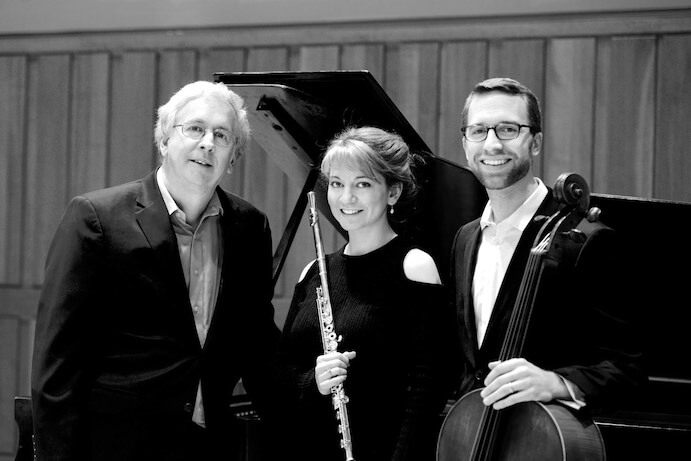I, constantly, must remind myself that when I first heard contemporary music, it was not a headlong dive into avant-garde experimentalism. The most engaging and exciting sounds were ones I could relate to the standard repertoire, because I had common ground enough to appreciate the differences and the framework in which these living composers operated. Dolce Suono Trio provides an excellent slice of that common ground with their Innova Recordings release, American Canvas. Mimi Stillman (flute) and Charles Abramovic (piano) are joined by brilliant cellists Nathan Vickery, Gabriel Cabezas, and Alexis Pia Gerlach as they present four contemporary works that provide a comfortable step into the language of New Music.
The album opens with the namesake work, American Canvas by Jennifer Higdon. This three-movement piece, inspired by the styles of three American painters, is an effective and concise snapshot of Higdon’s familiar tonal language. “O’Keeffe” flows through iterative, billowing harmonies; “Pollock” commits to a motoric ostinato-like drive, each instrument popping out of the texture to be immediately submerged; and “Wyeth” weaves pointillistic statements with constantly-evolving lines from all three players. The trio shines throughout the piece, balancing their impressive technique with a tender expressivity, and comfortably introducing the musical realm in which they seem happiest to dwell.

Dolce Suono Trio: Charles Abramovic, Mimi Stillman, and Nathan Vikcery
Stillman points out in the liner notes that these pieces let the performers “luxuriate in the myriad colors” their instruments create, a statement not necessarily warranted given the stylistic homogeneity of the album. However, if any piece pushes the coloristic tendencies of the group, it is Andrea Clearfield’s Spirit Island, the only work on the CD not commissioned by Dolce Suono. Inspired by a trip on Maligne Lake in Jasper National Park, Clearfield paints a vivid picture of the landscape. Her careful use of register and timbral modifications (from the use of natural harmonics and glissandi to simply requesting that the cellist not vibrate) creates a spacious sound world through which Dolce Suono expertly guides the listener.
Clearfield’s treatment of material particularly allows for this space. She is more gestural than the other three composers, her composition having more to do with the progression of space than contrasting melodies. This is especially true of her first movement, “Variations on a Dream,” in which she puts a four-note idea through a set of variations. Because of her attention to texture and excellent orchestration, this idea never feels overbearing. Instead, it creates a wholly natural evolution of music—it is easy to see how the furious closing section of this movement could have been contained in the spacious, soft piano clusters that open the work.
Following Spirit Island is Zhou Tian’s Viaje, a work reminiscent of Higdon’s opening work (Zhou, in fact, studied with Higdon). Viaje largely develops from dialogues between the cello and flute, representing Spanish nobleman El Cid and his daughters, respectively, as they navigate “childhood, separation, distrust, and finally, reunion.” The piece opens with a fast, virtuosic statement that eventually progresses to a lament-like duet between flute and cello before returning to the aggressive opening material to close. Viaje features some of the fieriest playing on part of the trio, but threatens to become overbearing with its sections. Zhou has an almost symphonic approach to form, which does not translate quite so smoothly when condensed into a nine–minute work.

Zhou Tian
The CD closes with the grandest and, unfortunately, least effective of the four selections. Shulamit Ran’s Moon Songs was commissioned by Dolce Suono Trio to serve as both an homage and companion piece to Schoenberg’s Pierrot Lunaire. The piece is hefty in scope, comprising four acts and two entr’actes, with text selections from various sources including the Bible, modern Israeli poetry, and excerpts from the Albert Giraud text used in Pierrot Lunaire. Lucy Shelton joins the Trio for the work and her vocal performance is strong throughout, though occasionally strains at the fringes of her range and dramatic scope.
The piece, which uses texts about or inspired by the moon, has a strong concept at its core that proves too unwieldy in its manifestation. The opening minutes of “Act I. Creation” are absolutely gripping and haunting, with the soprano’s dark vocalizations contrasting with soft instrumental accompaniment—however, the abrupt shift to a Jewish folk style at the end is neither anticipated nor adequately accounted for in the remainder of the work. Even the closing movement, which is entirely comprised of similar folk-like melodies, does not justify this insertion so early in the piece. These formal inconsistencies manifest at all levels—the second movement inexplicably dives into a pounding close that does neither the movement nor the text justice, while the final movement of folk-like settings are remarkably well-orchestrated and engaging as a unit, but leave a lot to be desired as the close of an otherwise heavy, dramatic composition.
What does not leave anything to be desired is the performance. Throughout American Canvas, Dolce Suono Trio (and their talented colleagues) prove over and over their skill as individuals and as an ensemble, showcasing four living American composers in the process. Dolce Suono Trio does not break new aesthetic ground by any means, but provides an installment in the fast-expanding repertoire for small chamber ensembles and a snapshot of American Neo-Romantic contemporary music.























